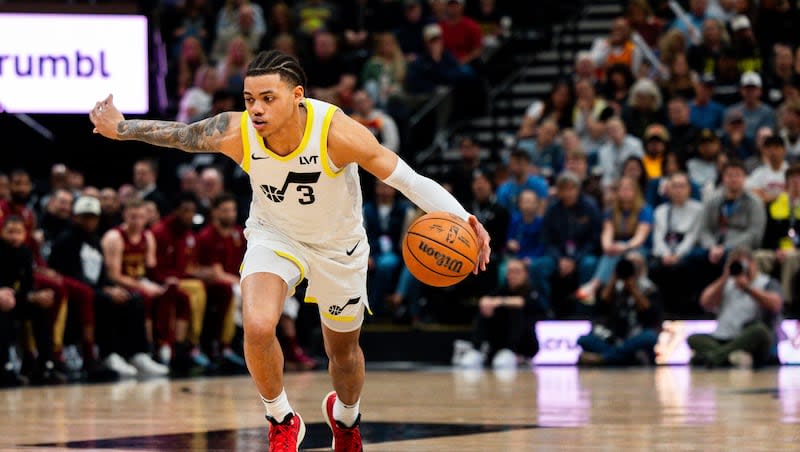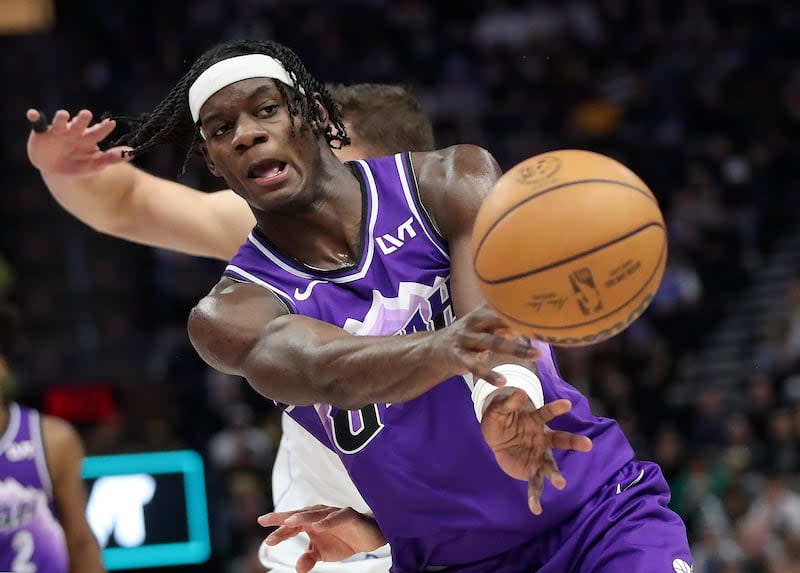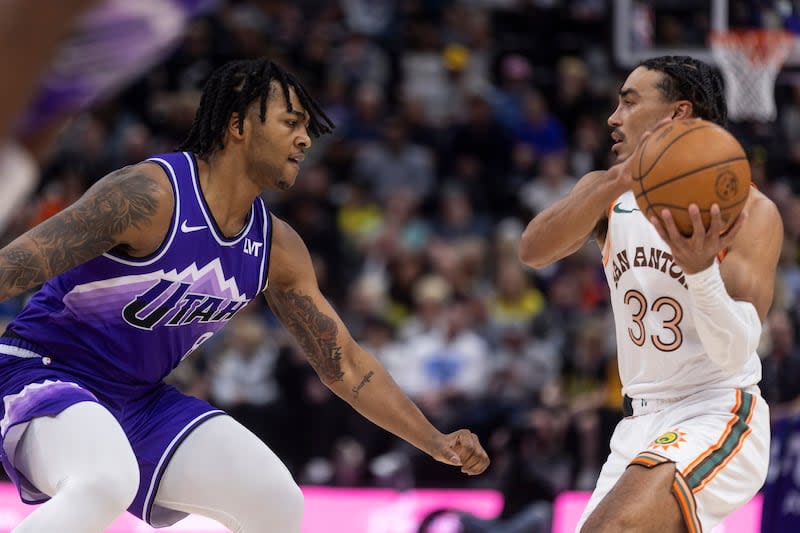Grading the Jazz: Rookies Taylor Hendricks, Keyonte George and Brice Sensabaugh showed flashes of what they’re capable of

Editor’s note: Fifth in a series of stories grading all the Utah Jazz players from the 2023-24 roster.
The Utah Jazz had three first-round draft picks — No. 9, No. 16 and No. 28 — in 2023. In a draft that was lauded as being filled with ultra-talented and skilled players, it made for some serious excitement and high expectations.
Taylor Hendricks, Keyonte George and Brice Sensabaugh all had really different experiences and took different paths in their first NBA season. I think one of the most important things to remember when considering the performance of each of them is that consistency on the roster was difficult to come by.
With the trade deadline moves the Jazz made, the constant experimenting with rotations and then the fact that the majority of the starters and regular rotation players ended up watching the final stretch of games from the bench, it meant that the rookies were often flanked by other rookies on the court or players that are not going to be a part of the Jazz’s future plans. That means that there are a lot of stretches of data that are unreliable or need a lot of context added to really get an idea of what was going on for the young players.
With all of that in mind, let’s get to some grades:
Taylor Hendricks — B
As the 2023 draft was approaching, Taylor Hendricks was expected to be a top-10 pick. With his length, outstanding athleticism, ability to shoot the ball and his defensive instincts, he stood out as one of the most promising prospects. The Jazz selected him with the ninth overall pick.
Because he had a minor hamstring injury during pre-draft workouts, he didn’t play in Summer League, but it wasn’t long after training camp began that it was clear that the then-19-year-old was going to have a long road ahead of him. Though many expected for Hendricks to be a quick plug-and-play rookie, he was a lot further away than many draft analysts originally thought and ended up starting out the year in the G League.
There does seem to be a shift in approach across the NBA with young players, and the G League is being utilized more than ever before, but that shift hasn’t completely transformed the expectations that are placed on lottery picks. So, if we’re looking at expectations vs. performance from Hendricks, he probably doesn’t grade that well. But, the Jazz knew that they were getting a project in Hendricks and they’re still banking on his long-term potential.
After the Jazz dealt Kelly Olynyk and Ochai Agbaji at the trade deadline, Hendricks was called back up to the NBA and very quickly thrown into the fire, often guarding the best player on the court, and, importantly, he wasn’t getting swallowed up. There’s certainly some growth that needs to happen, particularly with physical strength, the ability to navigate screens and not biting so hard on pump-fakes, but overall, I was impressed with how Hendricks handled himself.
What I was most impressed with on that side of the ball was Hendricks’ willingness to admit how much he still has to learn. He’s a really shy guy but as he started to come out of his shell toward the end of the season, he was honest about where he has room to grow but also really confident that he was going to make huge strides.

Offensively, there’s not much that’s being asked of Hendricks right now other than shooting the ball and trying to get extra possessions through rebounds. And although Hendricks often would rush his shot a little bit and take shots without his feet being set, he still showed that his ability to make shots is something that can be relied upon. Even in the 13 NBA games he played prior to the trade deadline — in garbage time or with inconsistent minutes — he shot 34.3% from deep. After the trade deadline, with a more consistent role, he shot 39% from long range.
There’s so much room for Hendricks to grow and we’re only just starting to scratch the surface with what his potential is. As far as his rookie year is concerned, he probably didn’t reach the expectations that were placed on him early on, but he definitely acquitted himself well.
Keyonte George — A-
Though not a lottery pick, Keyonte George was a bit of a surprise pick for the Jazz at No. 16. A lengthy wing player out of Baylor, George was expected to be a scorer who could score and score, and he could score a little more after that. In his lone season at Baylor he turned in a negative assist-turnover ratio, which did not inspire confidence in his ability to head up a guard line, but he shattered those beliefs before the summer was over.
By the time Summer League and training camp had wrapped up, the Jazz believed that they’d possibly found their point guard of the future in George, and it took just eight games of the regular season to pass by before the rookie took over at point in the starting lineup.
As the starting point guard, with the Jazz’s most talented players around him and a regular rotation, George averaged 12.7 points and 5.9 assists per game before he was sidelined with a left foot injury in mid-December. He was flourishing on both sides of the ball.
He continued to have success after returning from injury albeit from the bench. After the trade deadline, that trend continued as he again took on a starting role, but, as the rotation changed and he was asked to do more and more, he struggled a bit, mostly on the defensive side of the ball. This is where it might be a little unfair to judge George too harshly. He went from being the fifth guy on an opposing scouting report as the starting point guard to often being the top guy on a scouting report just purely based on who else was on the court.
While I would love to have seen the same amount of tenacity and effort on the defensive end at the end of the season, I recognize that George was doing a lot more than he was probably ready to handle and I think there should be some wiggle room here. He also needs more strength, he needs to get used to the kinds of shots he’s going to get at the NBA level, he needs to develop even more of a reliable interior game and he needs to make sure that his impact on defense is a priority, no matter who he shares the court with.
Overall, George exceeded expectations.
Brice Sensabaugh — B
The fact that Brice Sensabaugh — who’d had two knee surgeries by the time he declared for the NBA draft — came out of his rookie season healthy, is worthy of an A+. The Jazz drafted him 28th knowing that his injury history could be a problem, but with such a late pick in the first round it was a risk they were willing to take considering the scoring talent of Sensabaugh.
He has the type of body and athleticism that NBA scouts are always looking for — 6-foot-6, strong, broad, but still fast — and he can score the ball from anywhere on the court. Though, his defense in college was not good.
Like Hendricks, Sensabaugh started out the year in the G League for the Jazz but he was used even more sparingly than his rookie counterparts. He didn’t see any legitimate minutes until after the trade deadline. But, what he showed in the G League was pleasantly surprising. He was a much better passer than anyone had expected. He has incredible instincts and sees the game at a high level which makes him a great secondary playmaker. Additionally, that bad defense from college didn’t seem to tell the whole story.
After the trade deadline, Sensabaugh was used more often with the Jazz and there was a lot of carryover from the G League with his passing and effort defensively, but he really struggled to efficiently score until the trade deadline through the month of March. In the final 10 games of the season, Senabaugh seemed to find a comfortable rhythm and was shooting 37.7% from 3-point range, averaging 11.6 points, four rebounds and 2.3 assists per game.
There’s no telling what the Jazz are going to do this offseason and how it will impact rotations and minutes for the young players. If Sensabaugh is given a role, the hope is that he can pick up where he left off on offense and continue to grow the other parts of his game. It was a little disappointing not to see the scorer that we saw at Ohio State but it was great that he stayed healthy while showing there is more in his toolbox.

